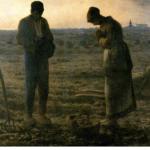
Doménikos Theotokópoulos, El Greco Wikimedia Commons
Analyzing Religious Art Series: A Deeper Exploration
In this ongoing series for An Exhibition Of Art History, I am going to be analyzing famous works of religious art. The focus will be religious symbolism, the history of the piece, biblical history and reference and my personal interpretation of the piece. I hope you enjoy this series as it will take on a wide variety of artistic expressions and spiritual avenues. Each article will represent one piece to keep a clean and deep understanding of it’s history and message. My first article explored the famous work of Rembrandt, The Return Of the Prodigal Son.
The second article of the series focused on The Calling of Saint Matthew by Caravaggio. You may follow this link to read more. The Virgin in Prayer by Giovanni Battista Salvi da Sassoferrato was the following subject. The Annunciation by the African-American painter Henry Ossawa Tanner was the last article.
Going back to basics, we will be looking into the deeply spiritual painting The Tears of Saint Peter (El Greco, Mexico City) by El Greco.
The Key to Heaven: The Tears of Saint Peter (El Greco, Mexico City) by El Greco (c.1587-1596)
This oil painting on canvas is a stunning revelation of repentance. The billowing blue and yellow robes close off the viewer’s eye toward the clasped hands of Saint Peter, in silent and deep prayer. What is more noticeable is in fact the large golden keys his left arms holds (also seen as the papal authority symbol). This symbolizes the promise Christ had made to Saint Peter of giving him the kingdom to heaven (Matthew 16: 19).
Mournful Repentance and Forgiveness through Christ
The story behind this infamous piece brings a deep sense of repentance as we see Saint Peter’s mournful and tearful expression directed heavenward, and in knowing the history of the piece itself we can see how deeply rooted that repentance goes. Looking to the left of the well known piece, there is a representation of the Magdalen returning from Christ’s empty tomb. This is significant as the announcement of Christ’s resurrection from an Angel is heard.
Saint Peter (30 AD to 64-68 AD), was regarded as the first bishop of Rome and one of the twelve apostles of Jesus Christ, being venerated as a major Saint and founder of the Roman Catholic church after his crucifixion in Rome under Emperor Nero.
In the Gospel of Matthew 16:19, Jesus says to Peter:
“I will give you the keys of the kingdom of heaven, and whatever you bind on Earth shall be bound in heaven, and whatever you loose on Earth shall be loosed in heaven.”
This verse showcases a great many parallels of heaven and earth and how they are linked. Our actions on earth deeply impact the spiritual wellness of our spirit and our relationship to God. The painting itself is a mournful expression of grief and guilt, as Saint Peter had denied Christ three times, and his deep repentance in asking for forgiveness to Christ is etched upon his deep in prayer stance and entire countenance.
El Greco painted six autograph variations of this same theme (Saint Peter) in Spain, inspiring many artists and poets for the depth of his artistic merit and interesting style (Expressionism and Cubism) that was not seen by his 14th-century contemporaries. This version was created for personal and private viewing, as the Greek painter believed there was a deep relationship to the viewer and the art.
First and Last Impressions
My first look at this astonishingly human portrait was of profound remorse. I could see how deeply and utterly regretful this man was for his actions against someone who had trusted him, as a friend and a follower. The fragility of mortals and their propensity to sin as well as committing deeply painful actions against someone they love and care for, is plainly shown here with Saint Peter’s incredibly melancholy eyes. I find that overall, I am left with a new sense of belonging to humanity and our flawed natures, feeling a sense of renewal in the prospects of God’s everlasting love toward His creation and the promise of forgiveness through repentance, forgiveness, reformation and through the practice of the sacrament of penance(a practice that reformers of the Catholic Church teaches).














